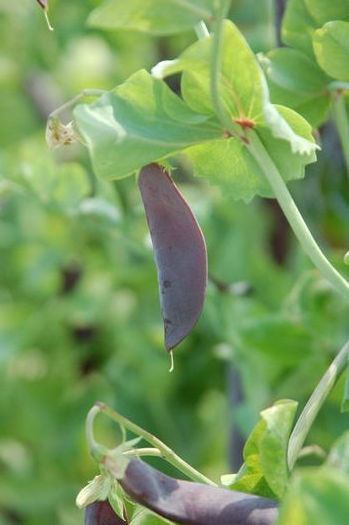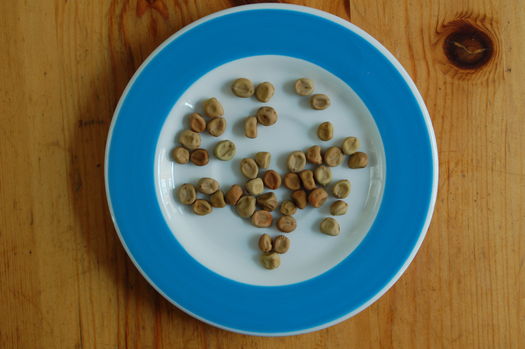
There is no food more typically Dutch, that you can grow in your garden, than the purple podded capucijner pea. In Holland nearly all the supermarkets carry jars of precooked capucijners, and everyone knows what they are.
The only edible part of the plant is the dried peas, which look like this (shown on a coffee saucer):

When cooked they stay whole, make their own rich gravy, and have a distinctive pea taste. They are frequently eaten with pork, but also taste nice just plain or cooked in other ways.


I have to say… You guys grow the most colorful collection of veggies I have ever seen! 🙂
Thanks Hanna! There’s more to come…
Mensje, ik krijg me daat toch een trek. Heb net gisteren twee pakken met capucijners gekregen van de hollandsche winkel.
Kan ik er een paar van af nemen en in de grond stoppen? Of zijn ze bewerkt met een preservatie middel?
Vanavond capucijners met spek, stroop, gebakken uitjes en appelmoes.
Loes
Hoi Loes, Dat was een toffe gast. Het zal waarschijnlijk mogelijk zijn om ze te planten. Ik zeg nog iets over dit in het engles. Eet smakelijk!
In English so everyone can understand:
Loes bought some dried capucijner peas from a Dutch food store in the US, and wants to know if she can just plant them.
I think so. I doubt they would have been treated. It’s possible they could be an F1 variety of plant, in which case they would be genetically unstable and not produce the same kind of peas if regrown. I don’t think this is a problem either because I have never seen an F1 variety of capucijner and I doubt they exist.
The seeds you have may be very old, so you may have a hard time getting them to grow. You might try doing a germination test by putting some in a few layers of wet paper towels for a week or two to see if they start growing.
Now is the wrong time of year to plant peas. Peas like cold weather, and can even tolerate some freezing. The best time is early spring (February or March) or in the Fall (August or September).
There are two main types of capucijners, Deseree which grow to about 1 meter high and Ezetha’s Krombek which grow to nearly 2 meters. Since you don’t know what kind you have, be prepared to provide some support if you can. If you can’t give them support, they will also probably grow okay on the ground.
Good luck!
Hi Patrick,
Hartelijk dank voor je vlugge antwoord.
Ik vond ook bij deze web site een order formaat en ik heb ze dus besteld. Wat ik niet wist is wanneer ze te planten.
Hier in Colorado wordt het erg koud met bevriezen van de grond tot een foot diep.
Wat ik zie op de foto lijkt het op sweet peas, en die groeien hier alleen maar als ze in het vroege voorjaar geplant worden.
Ik heb zaadjes van een oudere plant hoog in de bergen en die wil ik morgen planten na een nacht in water te hebben doorgebracht. Ik weet dus nog niet of dat lukt.
Maar ik zal proberen de capucijners in september te poten en ook de tuinbonen die ik hier heb gekocht.
Iets anders, heb je ook zaadjes voor komijn?
Groetjes, Loes
loesk@acsol.net
Hoi Loes,
Ik heb geen komijn. Als je op zoek naar komijn zaadjes, misschien kun je deze hier kopen: http://rareseeds.com/seeds/Herbs/Cumin
Succes met de capucijners en tuinbonen!
Groetjes, Patrick
thanks Lisa for the love of your seeds,always forest in salem ma.
Ik kook de capucijners net zoals mijn moeder dat vroeger deed.Dan eten we ze met uitgebakken spek,gebakken uitjes en kleine augurkjes.Liefst zuur.Ik ben hier nu 58 jaar maar eet nog steeds Hollandse kost.Draadjes vlees,boerenkoolmet worst,zuurkool,ennatuurlijk nasi goreng.heerlijk
Beste Else,
Bedankt for de bericht. Ik kom uit Chicago en woon in Nederland nu al 18 jaar, niet zo lang als jij woont in de VS! Ik vind de Hollandse keuken ook lekker. Eet smakelijk!
I am originally from Holland and my father was in the fruit and vegetable trade. When they were available, he brought fresh capucijners home. We would al sit around the table and help removing the pods. The peas were then cooked fresh and we would eat them with fried lardons (spek) and a bit of piccalilli on the side. Lovely! I live in England and unfortunately capucijners are unkown here. I have brought the dried ones back from Holland but I don’t think they are anything like fresh ones. I would say try and grow them. Vriendelijke groeten en eet smakelijk!
Hi, In June 2007 I made a trial sowing of dried capucijners (50) bought in a supermarket with at the same time a sowing of 50 seeds bought in a garden centre. They all came up but after a short growing period there was a marked difference. The seedlings from the seed merchant were far superior to the others. Willem
hi
Hi Willem,
Thanks for letting us know about your trial planting!
There are lots of different varieties of Capucijners and related peas around, and if you buy one from a real seed store (or garden center in Holland), at least you know you bought one intended for planting in a garden. What a farmer grows is probably different.
If anyone reading this wants to grow capucijners and doesn’t know where to get seeds, just send me an email or leave a comment here and I’ll try to help.
i’m looking to buy a pound or more of good quality capucijner seeds. do you know where i can order this in the united states?
thank you
ingrid
Hi Ingrid,
The two seed stores I know of in the US who sell capucijner seeds are:
http://www.amishlandseeds.com/
and
http://www.sandhillpreservation.com/
I have no idea if they sell pound quantities or not. Good luck, and I hope this helps.
Ik ben op zoek naar zaden voor capucijners
Ik woon in North California
Thanks
Steven
Hoi Steven, Bedankt voor de bericht. Ik stuur een email. (Thanks for the message, I’ll send you an email)
Hi! Here’s a challenge for you. I live in Australia and we’re not allowed to import seeds. Do you know anywhere in Australia?
Failing that, do you know the actual botanical name for capucijners?
Cheers
Eric Amon
The botanical name is easy, it’s Pisum sativum, the same as ordinary peas. Some seeds are easier than others to get into Australia, but I remember reading recently that peas are one of the things that need to be quarantined first.
On this page:
http://oldvegiepatch1972.googlepages.com/pea.html
this person talks about his purple podded peas, and posts pictures of them. He appears to be in Australia. There is an email address, so you might try sending him an email.
Failing that, you might want to get in touch with the Seedsavers Network that he links to on that page.
Good luck…
Hi Patrick
Nog heel erg bedankt voor de snijbonen ze staan ongeveer 10 cm boven de grond en kan niet wachten tot ze klaar zijn.Een vraag wat is de boon voor de snijboon in het engels.
Alvast bedankt Steven
Hoi steven! Leuk dat je terug bent.
Steven asked what the Dutch word ‘snijboon’ was in English. Good question, but there isn’t really an English word for it. It’s a common bean, just bred to be large. I would perhaps call it a ‘large romano bean’.
This size of bean just isn’t really common in English speaking countries. As far as I know you can’t buy it in either the US or UK.
You can buy seeds online here:
http://tuinboetiek.nl
or here:
https://www.vreeken.nl
In both cases, I think you need to send an email first and ask if they will send an order to the US.
Hi, I am growing cupucijner purple podded peas. I got the seeds from Heritage harvest seeds here in Canada. http://www.heritageharvestseed.com/index.html
It was suggested that the young pods made good edible pod peas but they were way too fibrous. They are about 2 meters high so tall ones.
The pods are full and the lower leaves are turning yellow. Should I pick them now or wait until they are completely dry? If I want to try them fresh when do I pick them? Any recipes anyone?
Hi Sarah,
It’s a rumour that never dies that the small pods are good for eating. I read it a lot, but it’s just not true. Chinese whispers or something. At least the plant just grows them back after you harvest them to eat…
If you want to eat them fresh, it sounds like they are pretty much ready. The pods should look very plump, but not dried out. If you want to eat them dry, then just let the plants completely die off.
Kathy and I discussed some recipes on her blog. I am vegetarian, but they are normally cooked with bacon or salt pork. Here’s what we said:
http://carletongarden.blogspot.com/2008/01/capucijner-peas-for-new-year.html
http://carletongarden.blogspot.com/2007/08/capucijner-peas.html
Probably the most authentic recipe I’ve seen is this:
http://www.odt.co.nz/lifestyle/food-wine/100531/winter-warmer-capucijners
Since you have them dry, and this recipe calls for them canned, you will need to soak them overnight and cook them first.
The most important thing is they make their own ‘gravy’, so be sure not to discard the cooking water. Also, without any spices the flavor is quite rich and tasty, so be very careful adding spices. Most people prefer it with few if any added spices. It usually needs something a little fatty or oily like bacon or vegetable oil to cut the starchiness, and it usually needs salt.
Thanks Patrick.
Hi. I was just wondering. I live in brisbane australia. Iv been looking for dryed kapuijners in australia. My mother said that we used to be able to get them from this old fruit shop. But its gone now. Have you heared of any place in aust i could get them.
Hi Mick,
I suggest looking for Dutch food shops, either in your area or maybe online. There are lots of Dutch expats in Australia, and this is a very typically Dutch food.
If you’re looking for seeds, there are a few aussie gardeners on this discussion forum who might be able to help:
http://alanbishop.proboards.com/
Good luck!
Patrick